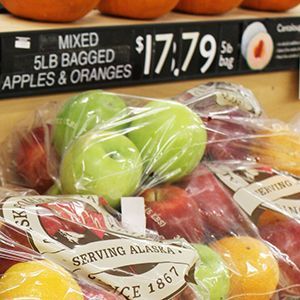
If anyone is used to cold weather, it’s the residents of Alaska’s arctic regions. Winters there can span from September to April, see only 4 to 5 hours of sunlight and have temperatures that can fall to -50 degrees. These facts can no doubt make everyday living difficult, but one big challenge in these glacial regions might surprise you.
Based in Anchorage, Food Bank of Alaska serves the entire state. Given Alaska’s relatively small population, this might not seem too difficult. But, Alaska is the largest U.S. state geographically at more than twice the size of Texas. There are areas within its expansive, arctic borders beyond what we would typically consider ‘rural.’ Some are only accessible by plane. This isolation – among other unique circumstances – leaves families there vulnerable to hunger, and makes it particularly challenging for Food Bank of Alaska to reach them with the food they need.
“The price of food in remote Alaska towns is incredibly high,” says Sarah Glaser, marketing and communication manager for Food Bank of Alaska. “It’s typical to see a gallon of milk for $10, or a loaf of bread for $6. ” Many living in these remote towns simply can’t afford to purchase all of their food at the grocery store. Alaska ranks highest for unemployment at 7.3% due to a large proportion of seasonal jobs dependent on the volatile oil, mining and fishing industries.
To offset the high cost of food, many rely on methods that have been practiced for centuries – subsistence hunting, fishing and foraging. Alaska’s Department of Fish and Game reports that over half of rural dwellers harvest wildlife. “The ability to hunt and gather foods such as caribou, walrus, salmon, and berries often mean the difference between having enough food or not,” Sarah says.
However, changing climates are threatening these traditional sources of food. The environmental impact of warmer winters, early springs, fluctuating storm patterns, thawing permafrost and fragile, shifting ice shelves have altered the migratory patterns of caribou and marine mammals – leaving them unreachable for critical subsistence hunting. These shifts have also hindered the ability to harvest and forage foods like kelp and berries that native residents have come to rely on.
“The rates of hunger in remote communities are high to begin with, but these changes mean we can expect them to soar even higher,” said Sarah. “At Food Bank of Alaska, we’re doing everything we can to stop this from happening.”
The food bank ships food to remote communities through a method called bypass mail – which is essentially low-cost air mail. While it’s considered low cost, it’s still much more expensive than the trucks that food banks in the lower 48 states use. They also have an advanced SNAP (food stamp) outreach program that flies staff to hard-to-reach communities. This allows outreach coordinators to fly commercial flights to “hub” cities and then take small planes to remote locations. SNAP is a lifeline for many in these communities who would otherwise go without.
“At Food Bank of Alaska, we realize there are unique challenges to serving our rural communities,” Sarah continued. “We’ll continue to send food out to these communities, but also work to implement the unique solutions they need. This includes finding sustainable initiatives that increase access to locally grown food as traditional approaches fade. We’ll also continue policy and advocacy work to protect important anti-hunger programs. Innovation and adaption are key to succeeding in our goal to end hunger in rural Alaska,” Sarah concluded.
“We won’t stop until we know everyone in our state – no matter where they live or what the season – has access to the food and resources they need to feed their families now and into the foreseeable future.”
Hunger exists in every community in the United States, even as far reaching as Alaska. The good news is you can help – every $1 can help provide at least 10 meals to a family in need through the Feeding America network of food banks. Please donate today.
